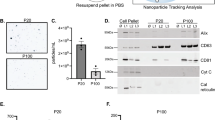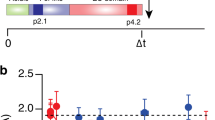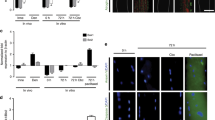Abstract
THE principal neurones of the rat superior cervical ganglion (SCG) can be established as dissociated cells in long term cultures1 without the survival of the small intensely fluorescent “interneurone” normally found in the animal. These isolated sympathetic neurones (SCGN) exhibit certain expected adrenergic characteristics such as the synthesis and accumulation of catecholamines2–4. They also specifically take up exogenous noradrenaline and demonstrate Ca2+-dependent release of this transmitter during induced depolarisation5. When these neurones are cocultured with thoracic spinal cord explants, they receive a typical cholinergic preganglionic input6. When cultured with the appropriate target of brown fat, the SCGN will provide characteristic noradrenergic contacts with the fat cells7. The interpretation of these generally expected results is confounded by the following observations: (1) cultures of dissociated sympathetic neurones form numerous synaptic contacts with each other8–10; (2) cytochemical studies of these synapses show that they contain predominantly dense-cored vesicles and thus appear to be noradrenergic8–11; and (3) physiological studies clearly indicate that synaptic signals between these cultured neurones are nicotinic-cholin-ergic7,11. In addition, dissociated SCGN will provide cholinergic innervation to striated muscle in culture12. Only one type of neurone, however, has been described in these cultures. We have investigated whether synaptic endings with the morphological characteristics of noradrenergic terminals were the only synaptic type to be found in cultures where cholinergic interactions between neurones were readily demonstrable. If, as previously reported, only synapses with noradrenergic cytochemical characteristics were found, it would strongly suggest that one synaptic type was handling both noradrenaline (NA) and acetylcholine (ACh). If two synaptic types were found it would suggest that two types of neurones were present in these cultured networks, thus providing a possible explanation for the paradoxical results discussed above.
This is a preview of subscription content, access via your institution
Access options
Subscribe to this journal
Receive 51 print issues and online access
$199.00 per year
only $3.90 per issue
Buy this article
- Purchase on Springer Link
- Instant access to full article PDF
Prices may be subject to local taxes which are calculated during checkout
Similar content being viewed by others
References
Bray, D., Proc. natn. Acad. Sci. USA., 65, 905–910 (1970).
Mains, R. E., and Patterson, P. H., J. Cell Biol., 59, 329–345 (1973).
Mains, R. E., and Patterson, P. H., J. Cell Biol., 59, 346–360 (1973).
Mains, R. E., and Patterson, P. H., J. Cell Biol., 59, 361–366 (1973).
Burton, H., and Bunge, R. P., Brain Res., 97, 157–162 (1975).
Ko, C-P., Burton, H., and Bunge, R. P., Brain Res. (in the press).
Ko, C-P., Burton, H., Johnson, M. I., and Bunge, R. P., Brain Res. (in the press).
Claude, P., J. Cell Biol., 59, 57a (1973).
Bunge, R. P., Rees, R., Wood, P., Burton, H., and Ko, C-P., Brain Res., 66 401–412 (1974).
Rees, R., and Bunge, R. P., J. comp. Neurol., 157, 1–12 (1974).
O'Lague, P. H., Obata, K., Claude, P., Furshpan, E. J., and Potter, D. D., Proc. natn. Acad. Sci. U.S.A., 71, 3602–3606 (1974).
Nurse, C. A., and O'Lague, P. H., Proc. natn. Acad. Sci. U.S.A., 72, 1955–1959 (1975).
Patterson, P. H., and Chun, L., Proc. natn. Acad. Sci. U.S.A., 71, 3607–3610 (1974).
Feldberg, W., Physiol. Rev., 25, 596–642 (1945).
Hebb, C. O., in Cholinesterase and Anticholinesterase Agents, Handbook of Experimental Pharmacology (edit. by Koelle, G. B.), 15, XV, 56–88 (Springer, Berlin, 1963).
Silver, A., Int. Rev. Neurobiol., 10, 57–109 (1967).
Yamauchi, A., Lever, J. D., and Kemp, K. W., J. Anat., 114, 271–282 (1973).
Ross, D., Cohen, A. I., and McDougal, D. B., Jr, Invest. Ophthal., 14, 756–761 (1975).
McCaman, R. E., and Hunt, J. M., J. Neurochem., 12, 253–259 (1965).
Fonnum, F., Biochem. J., 113, 291–298 (1969).
Author information
Authors and Affiliations
Rights and permissions
About this article
Cite this article
JOHNSON, M., ROSS, D., MEYERS, M. et al. Synaptic vesicle cytochemistry changes when cultured sympathetic neurones develop cholinergic interactions. Nature 262, 308–310 (1976). https://doi.org/10.1038/262308a0
Received:
Accepted:
Published:
Issue Date:
DOI: https://doi.org/10.1038/262308a0
This article is cited by
-
A century of exercise physiology: concepts that ignited the study of human thermoregulation. Part 3: Heat and cold tolerance during exercise
European Journal of Applied Physiology (2024)
-
Cholinergic neurones acquire adrenergic neurotransmitters when transplanted into an embryo
Nature (1986)
Comments
By submitting a comment you agree to abide by our Terms and Community Guidelines. If you find something abusive or that does not comply with our terms or guidelines please flag it as inappropriate.



